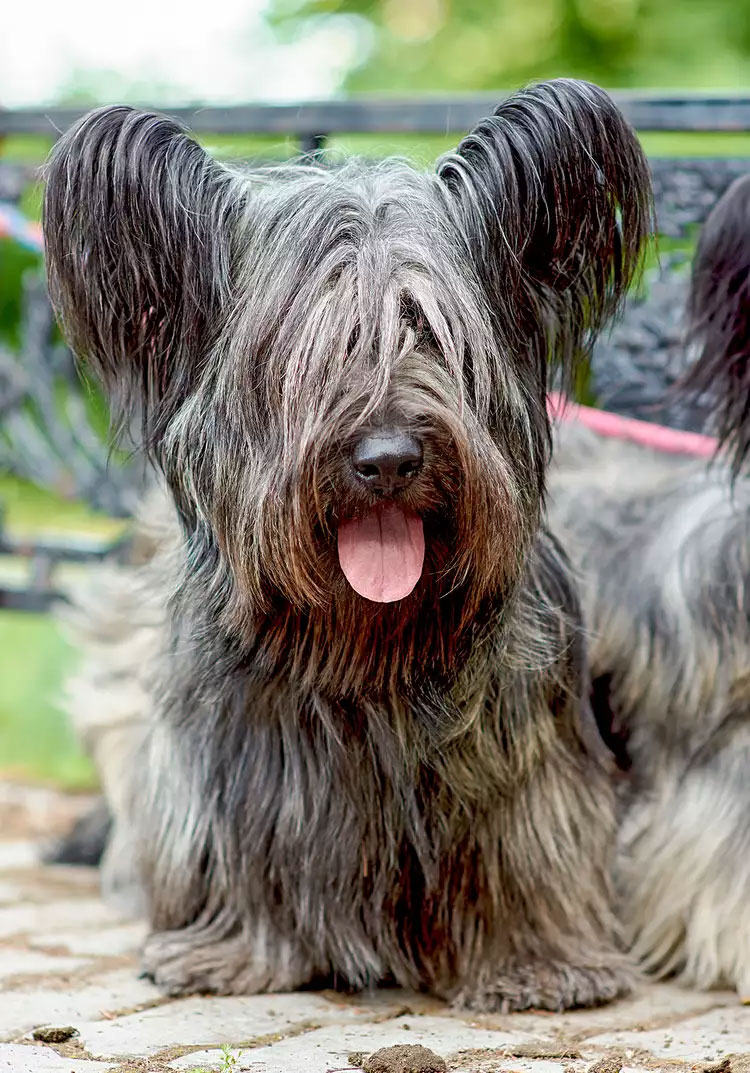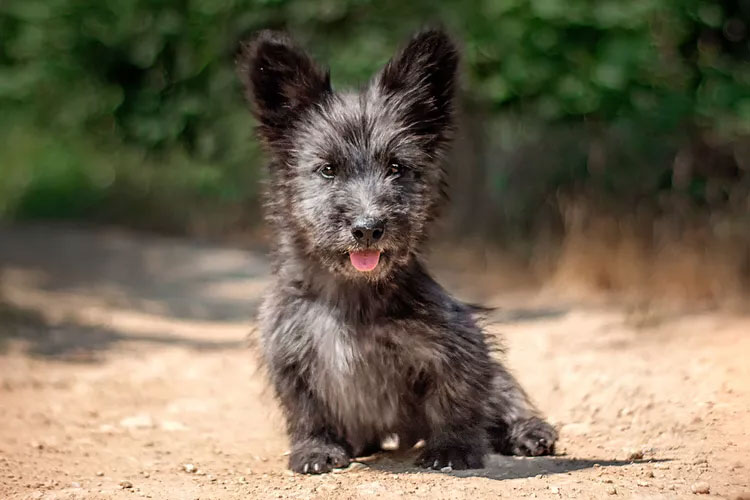Skye terriers are big-bodied, stumpy-legged dogs famous for their enduring loyalty. This rare breed is good-tempered, well-suited for apartment living, and doesn't need as much exercise as other terriers.

Skye Terrier Overview
| OFFICIAL NAME | Skye Terrier |
| COMMON NAME | Skye Terrier |
| PET HEIGHT | 9 to 10 inches |
| PET WEIGHT | 35 to 35 pounds |
| LIFESPAN | 12 to 14 years |
| GOOD WITH | children, dogs, families |
| TEMPERAMENT | friendly, willful |
| INTELLIGENCE | high |
| SHEDDING AMOUNT | occasional |
| EXERCISE NEEDS | medium |
| ENERGY LEVEL | active |
| VOCAL LEVEL | frequent |
| DROOL AMOUNT | low |
| BREED GROUP | terrier |
| BREED SIZE | medium (26-60 lbs.) |
| COAT LENGTH | long |
| COLORS | black, blue, cream, fawn, gray |
| PATTERNS | bicolor |
| OTHER TRAITS | apartment-friendly, easy to groom, good for first-time pet owners, strong loyalty tendencies |
The Skye terrier has quite the rags to riches story. These working dogs were bred by farmers on Scotland's Isle of Skye to hunt den dwellers like foxes and badgers that posed threats to crops. Before long, though, these terriers became a royal favorite in England and Scotland—so much so that it was said "a duchess would almost be ashamed to be seen in the park unaccompanied by her long-coated Skye," according to the Skye Terrier Club of America (STCA).
Today, this rare breed remains one that's defined by juxtapositions. She's elegant and graceful, yet tenacious and fearless.
The Skye terrier—a distinctive breed with a profuse and glamorous coat and a low-to-the-ground body—makes for a loyal and doting pet and could be a good match for first-time pet parents. These medium-sized dogs tend to be a bit calmer than their terrier peers and can also make great companions for families with older children and seniors. They have moderate exercise needs, and, while their coats look super spiffy, they surprisingly don't demand an extensive grooming routine. But these dogs are intensely loyal, so they'll do best in a home that can give them lots of attention.
Appearance
Skye terriers are considered to be a chondroplastic breed, which is a fancy way to say "big body, small legs." In fact, the low-to-the-ground and sturdy Skye terrier is twice as long as she is tall. These muscular dogs are only about 9–10 inches in height but weigh around 35 pounds.
The Skye terrier's elegant, draped coat is another distinct characteristic. The dog's undercoat is short, soft, and woolly, but her profuse overcoat falls straight down on both sides. Coat colors include black, blue, dark or light grey, silver platinum, fawn, or cream. While the long locks may look like they require a lot of upkeep, grooming is quite simple—Skye terriers just need a good weekly brush to keep their coat tangle-free.
Skye terriers are also known for their big, feathery ears that can either stand up or lie flat. (If you hear the expression "drop-eared Skye terrier," it means they have ears that hang down from the head instead of being upright at their base). Skye terriers also have brown, close-set eyes that beam with life and intelligence. And, like their ears, their tails are feathered, too.
Temperament
Skye terriers are known to be courageous, a trait linked back to their working days. But the Skye terrier personality is also good-tempered, loyal, and canny, according to the STCA. This is a breed that's friendly with her family but can be more reserved and cautious around strangers.
They are known to be loving and sweet dogs, with a tendency to be strong-willed," says Brian Evans, DVM, clinical director of Dutch.
The Skye is super smart and calmer than many terriers. Like all breeds, Skye terrier puppies need positive reinforcement training that's done consistently so they can become polite dogs.
"The Skye terrier is a good family pet but can be known to bark and be wary of strangers, so good socialization is needed early on in life," says Corinne Wigfall, DVM, BVS, BVM, consulting veterinarian with SpiritDog Training.
One thing to know about Skye terriers: They absolutely adore their humans. They're affectionate and will gladly cuddle all night, but they'll also like to accompany you on walks and playful romps in the yard during the day.
Living Needs
Due to their small size and moderate energy levels, Skye terriers can make great apartment dogs, Evans says. They do require daily exercise, so plan on giving them 30 minutes to an hour of playtime or walks every day, he suggests. In general, though, the STCA says "a Skye will usually be happy with whatever exercise his owner can handle," so these dogs could be up for longer walks and extra play sessions. But know that she can be a digger, so keep an eye on her when she's out in the yard.While the Skye terrier can do well with other dogs in the household, they might not be a good fit for homes that have small pets.
"Skye terriers will have their eye on smaller animals, so be careful having them around small pets like hamsters or gerbils, as they will view them as prey," Evans says.
Also, because these pups love their people so much, they won't want to be left home alone for too long.
At home, they'll likely fill a watchful role, says Julie Burgess, CPDT-KA, with Senior Tail Waggers. "They're constantly on guard towards strangers and unfamiliar noises," she says.
Care
While the Skye terrier's long locks look like she's difficult to maintain, grooming isn't anything to stress over. This breed requires a simple weekly brushing, and the STCA recommends using long-toothed combs and pin brushes with long pins when brushing the Skye's coat.Baths should be given once a month or so, but be careful not to scrub the dog's coat because it can cause her hair to mat. Instead, to help your Skye maintain her healthy coat, try squeezing or pulling the shampoo through her hair, the STCA advises. You can also dilute the shampoo so it works through the coat easily.
Other grooming rituals include trimming her nails every couple of weeks and cleaning your dog's ears on a weekly basis to help prevent any ear infections. A good teeth-brushing routine is also a must.

When it comes to training, Skyes do have a bit of a willful streak that's common among terriers. However, these are intelligent dogs who are eager to please their humans, so using positive reinforcement (and having lots of patience!) is key to success. While the Skye can be reserved by nature, training and socializing her at an early age will help her develop into a well-mannered dog that gets along with humans and other pet pals.
Health
Skye terriers are a generally healthy breed with lifespans that range between 12–14 years. However, they are prone to some health conditions, including ear infections, Wigfall says. This is why it's important to check their ears at least once a week and stay on top of regular cleanings.Skyes can also be susceptible to skin allergies. Wigfall suggests checking the dog's skin, including her belly and between her toes, for signs of redness, scabs, hair loss, or discharge.
Because of their build (long bodies that are low to the ground), Skye terriers can also be prone to disk injuries. It's important that owners don't allow their Skye terrier puppies to exercise excessively before the growth plates in their short legs have closed, according to the STCA. Also, Skye terrier puppies shouldn't be allowed to go up and down the stairs too much or jump up on hard surfaces.
Skye terrier owners should also be on the lookout for any potential signs of cancer, including mammary cancer and hemangiosarcoma, a fairly common canine cancer that can affect the heart.
History
Skye terriers were bred during the 1600s on Scotland's remote northwest Isle of Skye, where they worked as hunters. These fearless dogs navigated dens and burrows on their hunting expeditions, taking down badgers, foxes, and otters.But these working farm dogs with long, fancy coats eventually caught the attention of British nobles, according to the STCA, and they became royal pets. The breed gained notoriety in the mid-19th century as Queen Victoria kept a Skye terrier and began breeding the dogs in her royal kennels. The breed soared in popularity, though Skye terriers are less common today.
The American Kennel Club officially recognized the Skye terrier in 1887. While she is a rare breed in the United States, the Skye remains more popular across the pond in England and Scotland.
Fun Facts
One of the most faithful and famous Skye terriers of all time is known as Greyfriars Bobby, who guarded his owner's grave for 14 years during the mid-19th century. In 1961, Disney made a movie about the dog, Greyfriars Bobby: A True Story of a Dog. There is a commemorative statue of the loyal pup in Edinburgh, Scotland.Queen Victoria famously had a kennel of Skye terriers. But Mary, Queen of Scots, also was a fan of the breed. Her devoted Skye terrier stayed at her side during her execution, hiding underneath the full skirt of her dress.
Painter and sculptor Sir Edwin Landseer often painted Skye terriers, helping popularize the breed during the Victorian era.